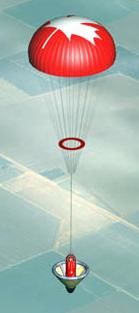
Home - Search - Browse - Alphabetic Index: 0- 1- 2- 3- 4- 5- 6- 7- 8- 9
A- B- C- D- E- F- G- H- I- J- K- L- M- N- O- P- Q- R- S- T- U- V- W- X- Y- Z
Wild Fire
 Wild Fire |
Status: Study 2004. Payload: 400 kg (880 lb). Thrust: 44.10 kN (9,914 lbf). Gross mass: 3,300 kg (7,200 lb). Unfuelled mass: 1,500 kg (3,300 lb). Height: 4.88 m (16.01 ft). Diameter: 1.42 m (4.65 ft).
Wild Fire was a concept of the Da Vinci Project, led by Brian Feeney of Toronto, Ontario, Canada. The concept envisioned air launch from balloon, following by a parachute descent on land touchdown. The da Vinci Project was to launch its spacecraft from a large helium balloon. The rocket was to be tethered 600 meters below the 25-story balloon and lifted over the course of an hour to an altitude of 24 km. A liquid oxygen/kerosene engine would place the vehicle on an initial angular trajectory to clear the balloon. The spacecraft was then to transition to vertical flight, rocketing to an apogee of 120 km in space. The rocket was to be reach a maximum speed on both its ascent and re-entry of Mach 4, or 4,250 kph. An innovative ballute was to protect and stabilize the rocket on re-entry. A flyable parachute was to deploy at 3 km altitude, allowing the vehicle to be guided by GPS to a predetermined landing zone. The da Vinci Project successfully conducted full-scale rocket motor tests and built a full-scale mock-up of their vehicle.
The Wild Fire crew capsule was a 1.42 meter diameter sphere , pressurized to 1 atm. The crew was also provided with pressure suits as a back-up. Six oval windows wrapped around it for a spectacular view at apogee. The propulsion system consisted of two gimbaled (3-axis), pressure fed 2,300 kgf thrust rocket engines, burning kerosene and liquid oxygen. The Reaction Control System used cold gas helium integrated with GPS and INS for flight guidance. The RCS would take advantage of the large on-board supply of helium that drives the fuel to the main engines. For recovery there was one main parafoil and one back up chute, with an additional back up chute on the separable capsule. A fully reusable balloon was used as a launch platform
The rocket's structure was a combination of a 6 point truss work integrated to a carbon fiber aeroshell. The pilot's seat was centered with the two remaining seats angled to the side. Flight control was achieved through a programmable FAA approved autopilot from a turbine class of aircraft. Outputs fed into the RCS and fully gimbaled engines to maintain the attitude and course of the rocket. In addition, the pilot also had two control sticks, one for the RCS and one to control the engine gimbals. Interruption and re-engagement of the autopilot was performed in the same manner in standard aircraft.
Reentry and landing was achieved through the deployment of an inflated shuttlecock to increase surface area and maintain passive static stability. An inflated blunt conical cone was deployed at the base to protect the engines on re-entry and to provide an airbag effect for landing. A parachute was deployed to slow the vehicle for final landing.
Family: Manned spacecraft, Suborbital. Country: Canada. Launch Vehicles: Scorpius. Agency: Da Vinci. Bibliography: 7023.
2001 March 9 - . Launch Vehicle: Scorpius.
- Scorpius SR-XM-1 suborbital rocket test - . Nation: USA. Program: X-Prize. Spacecraft Bus: X-Prize. Spacecraft: Wild Fire. Suborbital test of the Scorpius low-cost rocket concept. Later X-Prize contendor the da Vinci Project (Toronto, Canada) claimed this as a test of their "double engine propulsion system configuration"..
Back to top of page
Home - Search - Browse - Alphabetic Index: 0- 1- 2- 3- 4- 5- 6- 7- 8- 9
A- B- C- D- E- F- G- H- I- J- K- L- M- N- O- P- Q- R- S- T- U- V- W- X- Y- Z
© 1997-2019 Mark Wade - Contact
© / Conditions for Use